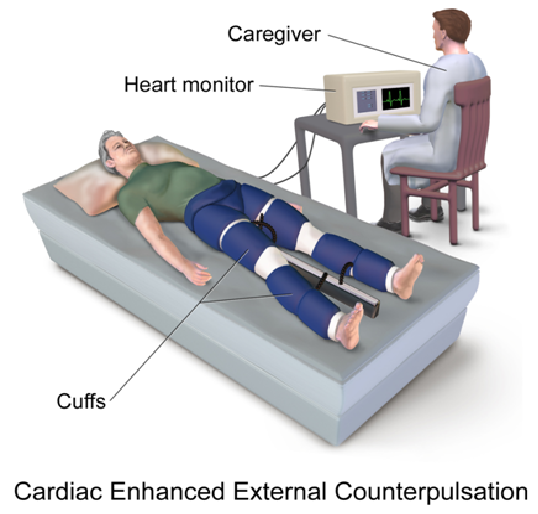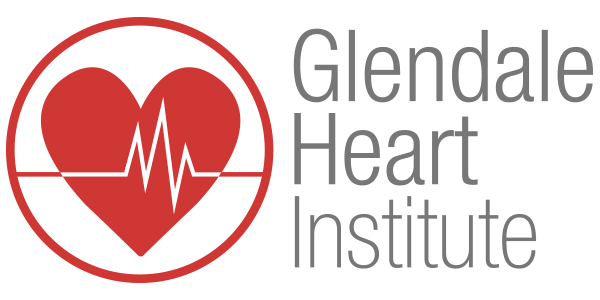Patients with severe angina who are not considered to be candidates for angioplasty or bypass surgery may benefit from external counter pulsation (ECP). Some patients with congestive heart failure also have had good results with the treatment. This non-invasive procedure is believed to help stimulate the growth of new blood vessels in the heart and, in some cases, improves the flow of existing blood vessels. Often, ECP is used when physicians have exhausted other therapies. ECP also may be used in addition to bypass surgery and angioplasty to enhance the benefits of these two procedures.
Preparing for External Counter Pulsation Treatment
No preparation is necessary for ECP. In most cases, the procedure is done on an outpatient basis. It is suggested that patients wear clothes that are tight-fitting and elastic to prevent irritation from the cuffs and follow medication and exercise instructions as directed by their physician.
Who Should Not Receive External Counter Pulsation Treatment
There are number of conditions and situations which may prevent patients from being eligible to have ECP treatment.
Preparing for External Counter Pulsation Treatment
No preparation is necessary for ECP. In most cases, the procedure is done on an outpatient basis. It is suggested that patients wear clothes that are tight-fitting and elastic to prevent irritation from the cuffs and follow medication and exercise instructions as directed by their physician.
Who Should Not Receive External Counter Pulsation Treatment
There are number of conditions and situations which may prevent patients from being eligible to have ECP treatment.
• Deep Vein thrombosis
• Elevated heart rate
• Heart valve disease
• High blood pressure
• An inability of the blood to coagulate (clot)
• Pacemakers
• Phlebitis (inflammation of a vein)
• Pregnancy
• Uncontrolled arrhythmia (altered heart rhythm)
What to Expect During External Counter Pulsation Treatment
An ECP treatment usually takes about one hour. Treatment is daily and may extend from five to twelve weeks or more. Patients are placed on a comfortable table and pneumatic stockings or cuffs are fitted to the calf and lower and upper thighs on each leg. These cuffs are hooked-up to a monitor which enables the physician to make adjustments to the pressure as necessary.
The cuffs are choreographed to inflate and deflate based on the results of an electrocardiogram (EKG), which measures heart rhythm. First, the calf cuffs inflate, followed by the lower thigh cuffs, ending with the upper thigh cuffs. The cuffs deflate as the heart starts another beat. Because ECP increases the pressure on the blood flowing through the aorta while the heart is at rest, the heart receives extra oxygen enriched blood.
• Elevated heart rate
• Heart valve disease
• High blood pressure
• An inability of the blood to coagulate (clot)
• Pacemakers
• Phlebitis (inflammation of a vein)
• Pregnancy
• Uncontrolled arrhythmia (altered heart rhythm)
What to Expect During External Counter Pulsation Treatment
An ECP treatment usually takes about one hour. Treatment is daily and may extend from five to twelve weeks or more. Patients are placed on a comfortable table and pneumatic stockings or cuffs are fitted to the calf and lower and upper thighs on each leg. These cuffs are hooked-up to a monitor which enables the physician to make adjustments to the pressure as necessary.
The cuffs are choreographed to inflate and deflate based on the results of an electrocardiogram (EKG), which measures heart rhythm. First, the calf cuffs inflate, followed by the lower thigh cuffs, ending with the upper thigh cuffs. The cuffs deflate as the heart starts another beat. Because ECP increases the pressure on the blood flowing through the aorta while the heart is at rest, the heart receives extra oxygen enriched blood.

After External Counter Pulsation Treatment
After the early treatments, a patient may feel fatigued but this is generally short-lived. Over the coming weeks, as the patient progresses through the treatment, there may be an increase in stamina and energy.
Patients generally are instructed to resume normal activities immediately after an ECP treatment. However, it is always best to follow the physician’s instructions which may also include not smoking, exercising, reducing stress, losing weight and maintaining a healthful diet.
Side effects of ECP are generally mild and rarely become severe enough to discontinue treatment. They include:
• Fatigue
• Headache or dizziness, generally mild
• Muscle aches
• Skin irritation or chafing around the cuffs
• Sores on the leg where pressure has been applied
If any of these symptoms cannot be described as mild or transitory, please contact your physician.
After the early treatments, a patient may feel fatigued but this is generally short-lived. Over the coming weeks, as the patient progresses through the treatment, there may be an increase in stamina and energy.
Patients generally are instructed to resume normal activities immediately after an ECP treatment. However, it is always best to follow the physician’s instructions which may also include not smoking, exercising, reducing stress, losing weight and maintaining a healthful diet.
Side effects of ECP are generally mild and rarely become severe enough to discontinue treatment. They include:
• Fatigue
• Headache or dizziness, generally mild
• Muscle aches
• Skin irritation or chafing around the cuffs
• Sores on the leg where pressure has been applied
If any of these symptoms cannot be described as mild or transitory, please contact your physician.
Cardiac Specialty Care
• Structural Heart Disease
• TAVR
• CardioMEMS (Heart Failure)
• PFO Closure
• TAVR
• CardioMEMS (Heart Failure)
• PFO Closure
• Coronary Intervention
• Complex Higher-Risk (And Indicated) Patients (CHIP) Angioplasty
• Atherectomy
• Impella and ECMO Support
• Complex Higher-Risk (And Indicated) Patients (CHIP) Angioplasty
• Atherectomy
• Impella and ECMO Support
• Peripheral Angioplasty
• Varicose Vein Treatment (Venous Ablation)
• DVT thrombectomy - IVC filter
• Carotid Stenting
• Varicose Vein Treatment (Venous Ablation)
• DVT thrombectomy - IVC filter
• Carotid Stenting
• Rhythm Management
• Pacemaker
• Holter Monitoring
• Exercise Stress Test
• Echocardiography
• Nuclear Stress Test
• Enhanced External Counterpulsation (EECP)
• Pacemaker
• Holter Monitoring
• Exercise Stress Test
• Echocardiography
• Nuclear Stress Test
• Enhanced External Counterpulsation (EECP)
